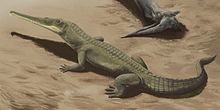镶嵌踝类
| 镶嵌踝类 化石时期:三叠纪到现代
| |
|---|---|

| |
| 脸龙属 | |
| 科学分类 | |
| 界: | 动物界 Animalia |
| 门: | 脊索动物门 Chordata |
| 纲: | 爬行纲 Reptilia |
| 下纲: | 主龙形下纲 Archosauromorpha |
| 演化支: | 鳄脚类 Crocopoda |
| 演化支: | 主龙型类 Archosauriformes |
| 演化支: | 真鳄脚类 Eucrocopoda |
| 演化支: | 镶嵌踝类 Crurotarsi Sereno & Arcucci, 1990 |
| 演化支 | |
镶嵌踝类(Crurotarsi)是一个主龙形类演化支,该演化支包括主龙类和已灭绝的植龙目[1]。
分类历史
[编辑]由保罗·塞里诺(Paul Sereno)在1990年建立,曾经用来取代旧的伪鳄亚目[2]。
塞里诺在2005年作出镶嵌踝类的种系发生学定义:亲缘关系较亲近于尼罗鳄,而离家麻雀较远的所有物种;也就是亲缘关系较亲近于鳄鱼,而离鸟类较远的所有物种。镶嵌踝类曾经是鸟颈类主龙(亲缘关系较亲近于鸟类,而离鳄鱼较远)的姐妹演化支。
Nesbitt在2011年的一项研究提出了镶嵌踝类的新定义,包括现代鳄鱼,鸟类和植龙的共同祖先的所有后代。[1]根据Nesbitt及其同事在2011年发表的两项研究,使用任何定义中的任何一种都会导致镶嵌踝类包含所有主龙类,因为植龙目的分类可能在主龙类的基干位置中。如果将植龙目和伪鳄类组成一个分支,同时排除鸟跖类(翼龙,非鸟恐龙和鸟类)将会导致出现一个并系群。一个更准确的分支是伪鳄类(Pseudosuchia),它的定义与镶嵌踝类2005年的旧定义相匹配[1][3] 。
系统发生学
[编辑]保罗·塞里诺和A. B. Arcucci于1990年命名镶嵌踝类,并将其定义为“植龙目,鸟鳄科,迅猛鳄属,Suchia,以及他们共同祖先的所有后代”[2]。
在镶嵌踝类命名之前,就已经提出两种名称用于容纳鳄鱼分支主龙。 第一种是伪鳄类(Pseudosuchia),于1985年定义为[4]包括亲缘关系较亲近于鳄鱼,而离鸟类较远的所有物种。第二种是鳄型踝关节类(Crocodylotarsi),于1988年命名,作为伪鳄类的潜在替代名称[5]。Pseudosuchia的意思是“假鳄鱼”,已经使用一个多世纪,传统上包括坚蜥目。根据1985年的定义,伪鳄类将包括真鳄类。鳄型踝关节类可能的命名原因是为了消除混淆,它与1985年定义的伪鳄类同义。由于伪鳄类首先定义,具有优先权,因此鳄型踝关节类成为了伪鳄类的异名[6]。
在2011年,Sterling J. Nesbitt发现植龙目是主龙类的姐妹演化支,因此不是鳄鱼分支主龙。 由于植龙目包含在镶嵌踝类的定义中,由于植龙目的系统发育位置变化导致镶嵌踝类的范围扩大,因此镶嵌踝类包括植龙目、伪鳄类和鸟跖类(翼龙,非鸟恐龙和鸟类)。
下面是Nesbitt(2011)修改的系统发育树[1]:
| 主龙形类 |
| ||||||||||||||||||||||||||||||||||||||||||||||||
下面是Nesbitt&Norell(2006)和Nesbitt(2007)的系统发育树,2011年之前的镶嵌踝类只包括鳄鱼分支主龙:[7][8]
| 主龙形类 |
| |||||||||||||||||||||||||||||||||||||||||||||||||||
Brusatte,Benton,Desojo和Langer的系统发育树(2010)[9]
| 主龙形类 |
| ||||||||||||||||||||||||||||||||||||||||||||||||||||||||||||||||||
参考资料
[编辑]- ^ 1.0 1.1 1.2 1.3 Nesbitt, S.J. The early evolution of archosaurs: relationships and the origin of major clades (PDF). Bulletin of the American Museum of Natural History. 2011, 352: 1–292 [2019-07-02]. doi:10.1206/352.1. (原始内容 (PDF)存档于2019-07-01).
- ^ 2.0 2.1 Sereno, P.C.; Arcucci, A.B. The monophyly of crurotarsal archosaurs and the origin of bird and crocodile ankle joints. Neues Jahrbuch für Geologie und Paläontologie, Abhandlungen. 1990, 180: 21–52.
- ^ Gauthier, J. A.; Nesbitt, S. J.; Schachner, E. R.; Bever, G. S.; Joyce, W. G. The bipedal stem-crocodilian Poposaurus gracilis: inferring function in fossils and innovation in archosaur locomotion. Bulletin of the Peabody Museum of Natural History. 2011, 52: 107–126. doi:10.3374/014.052.0102.
- ^ Gauthier, J.A.; Padian, K. Phylogenetic, functional, and aerodynamic analyses of the origin of birds and their flight. Hecht, M.K.; Ostrom, J.H.; Viohl, G.; Wellnhofer, P. (编). The Beginnings of Birds. Eichstatt: Freunde des Jura-Museums. 1985: 185–197.
- ^ Benton, M.J.; Clark, J.M. Archosaur phylogeny and the relationships of the Crocodylia. Benton, M.J. (编). Phylogeny and Classification of the Tetrapods 1. Oxford: Clarendon Press. 1988: 295–338.
- ^ Brochu, C.A. Synonymy, redundancy, and the name of the crocodile stem-group. Journal of Vertebrate Paleontology. 1997, 17 (2): 448–449. doi:10.1080/02724634.1997.10010992.
- ^ Nesbitt, SJ; Norell, MA. Extreme convergence in the body plans of an early suchian (Archosauria) and ornithomimid dinosaurs (Theropoda). Proceedings of the Royal Society of London B: Biological Sciences. 2006, 273 (1590): 1045–1048 [2019-07-02]. PMC 1560254
 . PMID 16600879. doi:10.1098/rspb.2005.3426. (原始内容存档于2017-08-16).
. PMID 16600879. doi:10.1098/rspb.2005.3426. (原始内容存档于2017-08-16).
- ^ Nesbitt, S. The anatomy of Effigia okeeffeae (Archosauria, Suchia), theropod-like convergence, and the distribution of related taxa (PDF). Bulletin of the American Museum of Natural History. 2007, 302: 84 [2019-07-02]. doi:10.1206/0003-0090(2007)302[1:taoeoa]2.0.co;2. (原始内容 (PDF)存档于2007-07-05).
- ^ Brusatte, Stephen L.; Benton, Michael J.; Desojo, Julia B.; Langer, Max C. The higher-level phylogeny of Archosauria (Tetrapoda: Diapsida). Journal of Systematic Palaeontology. 2010, 8 (1): 3–47 [2019-07-02]. doi:10.1080/14772010903537732. (原始内容存档于2019-09-15).
- Benton, M. J. Vertebrate Paleontology 3rd. Blackwell Science. 2004.
- Dunham, W. Lucky break allowed dinosaurs to rule Earth. Reuters. 2008-09-12 [2012-01-14]. (原始内容存档于2019-07-02).
- Brusatte, S. L.; Benton, M. J.; Ruta, M.; Lloyd, G. T. Superiority, Competition, and Opportunism in the Evolutionary Radiation of Dinosaurs (PDF). Science. 2008-09-12, 321 (5895): 1485–1488 [2012-01-14]. PMID 18787166. doi:10.1126/science.1161833. (原始内容 (PDF)存档于2014-06-24).










